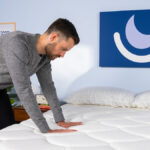Medical Disclaimer: The following content should not be used as medical advice or as a recommendation for any specific supplement or medication. It is important to consult your health care provider prior to starting a new medication or altering your current treatment.
Waking up with a headache is a frustrating way to start the day, but it’s an unfortunate reality for up to 30% of people with untreated sleep apnea. Although the usual signs of sleep apnea are breathing problems and daytime sleepiness, morning headaches can also be evidence of this sleep disorder.
We discuss the various types of sleep apnea headaches that may occur, what causes them, and how to treat and prevent them.
Can Sleep Apnea Cause Headaches?
A morning headache is a common symptom of both obstructive and central sleep apnea (diagnosable with a home sleep apnea test), but the exact cause of these headaches is unclear. Multiple factors may contribute to this painful and bothersome symptom.
People with sleep apnea experience pauses in breathing while asleep, leading to low oxygen levels and a buildup of carbon dioxide. This buildup may cause the brain’s blood vessels to expand and put pressure on the inside of the head, both of which can contribute to a headache.
Sleep apnea headaches may also result from poor sleep quality. When breathing pauses during sleep, people with sleep apnea awaken slightly to catch their breath. These frequent interruptions in sleep can lead to many symptoms such as daytime sleepiness, memory issues, and even headaches.
What Does a Sleep Apnea Headache Feel Like?
A sleep apnea headache most often feels like a continuous pressing or tightening on the front of both sides of the head, making it similar to a tension headache. People tend to experience sleep apnea headaches right after waking up in the morning, but the headaches can persist for hours afterward.
Sleep apnea may also be related to cluster headaches. These painful headaches usually affect one side of the head near the eye and may be accompanied by a visual aura, nausea, or a swollen face. These headaches may wake people up in the middle of the night and can last up to three hours.
Headaches caused by sleep apnea aren’t likely to cause visual disturbances, abnormal sounds, or nausea, all of which are typical signs of migraine headaches. Sleep apnea doesn’t cause new migraines to occur, but sleep apnea and the sleep disturbances it causes may increase the frequency and severity of migraines.
Anyone who has headaches upon waking up should speak with their doctor to determine the exact cause and best treatment options. Having constant headaches upon waking up can be a sign of serious underlying health issues besides sleep apnea.
Is Your Morning Headache From Sleep Apnea?
Your morning headache could be from sleep apnea or another condition that also causes them. The telltale signs of sleep apnea are:
- Feeling drowsy during the day
- Snoring
- Gasping for air or choking while asleep
If you experience any of these symptoms in addition to your morning headaches, talk to your doctor about whether you may have sleep apnea. Sleep apnea is most common in men, older adults, post-menopausal women, and people with obesity.
Sleep apnea is not the only condition that causes morning headaches. Other conditions that could be to blame include:
- Teeth grinding
- Migraines
- Caffeine withdrawal
- Overuse of certain medications
- Insomnia
- Breathing issues associated with obesity
- Spine disorders
- Chronic obstructive pulmonary disease
Speak with your doctor to determine the cause of your morning headaches.
How to Get Rid of Sleep Apnea Headaches
The best way to treat sleep apnea headaches is to treat sleep apnea itself. If you haven’t been diagnosed yet but are experiencing symptoms of sleep apnea, talk to your doctor.
Your doctor may recommend a sleep study to further test you for sleep apnea. During a sleep study, specialists monitor your breathing and other symptoms while you spend the night at a sleep clinic in order to help diagnose sleep apnea or other sleep-related conditions. Home sleep studies are another option.
If you’ve already been diagnosed with sleep apnea, make sure to keep up with your doctor appointments and treatment. While there is no cure for sleep apnea, managing your symptoms according to your treatment plan is the best way to minimize sleep apnea headaches.
Lifestyle Changes
Certain changes in behavior can improve sleep apnea symptoms. Weight loss has been shown to significantly reduce symptoms of sleep apnea. People who have sleep apnea and obesity may benefit from a weight loss treatment that incorporates exercise, dietary changes, medications, or in some cases, surgery.
Changing sleep positions may also benefit people with sleep apnea. People tend to have worse sleep apnea symptoms while sleeping on their backs, as this position can prevent proper airflow. By contrast, sleeping on the side may improve breathing during sleep.
People with sleep apnea are also advised to stay away from substances that may impact sleep, such as alcohol and sedatives.
Positive Airway Pressure (PAP) Therapy
PAP therapy is the recommended treatment for most adults with sleep apnea. This treatment involves a machine that provides a steady stream of air pressure to your nose or mouth. PAP therapy reduces pauses in breathing and lessens the impact of many sleep apnea symptoms.
Oral Appliances
Oral appliances are devices worn in the mouth to improve breathing during sleep. Some oral appliances are designed to hold the lower jaw forward, while others provide suction to the tongue to pull it slightly out of the mouth. While oral appliances aren’t as effective or well-studied as PAP therapy, they may be helpful for some people with sleep apnea.
Doctors may also recommend oral appliances to treat teeth grinding, another common cause of morning headaches.
Surgery
Some people with sleep apnea may benefit from various types of surgery. For example, if enlarged tonsils are blocking the airways, tonsil-removing surgery may improve sleep apnea symptoms. Other surgical treatments for sleep apnea can reshape the palate or implant devices to stimulate the muscles of the throat.
References
Ask the Sleep Doctor
Have questions about sleep? Submit them here! We use your questions to help us decide topics for articles, videos, and newsletters. We try to answer as many questions as possible. You can also send us an email. Please note, we cannot provide specific medical advice, and always recommend you contact your doctor for any medical matters.

